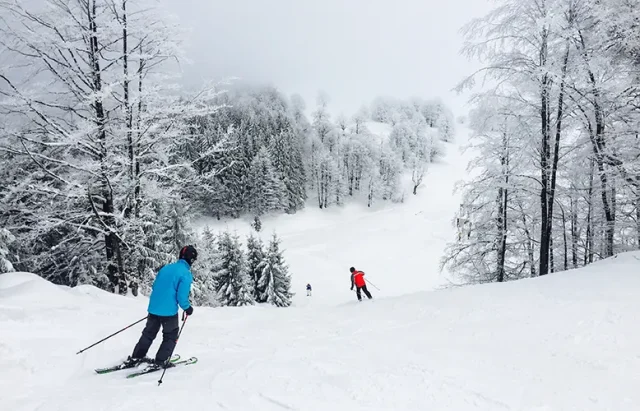
Skiing and snowboarding are exhilarating winter sports that draw enthusiasts from around the world to the stunning slopes of snow-covered mountains.
While safety regulations are crucial for a smooth experience, there exists an unspoken code of etiquette that adds an extra layer of harmony to the snowy landscapes.
Gary Clark, expert in gap year adventures and Academy Director at Basecamp commented: “The notion that in order to be a respected skier or snowboarder, you have to go fast down the mountain couldn’t be further from the truth. Completely the opposite. Being able to follow mountain etiquette, whether you are a novice or a seasoned shredder, fosters camaraderie and earns respect within the snow sports community.”
In this article, ski course provider Basecamp delves into the secret code of the slopes, exploring the nuanced lingo and cultural variations that may differ across countries and age groups to prepare you for a smooth experience on the slopes.
Everyone benefits from following the rules:
Safety first: the unwritten rules
Before hitting the slopes, every skier and snowboarder is expected to familiarise themselves with the basic safety rules outlined in the rules of conduct by FIS (International Ski and Snowboard Federation).
“These are basically the ten commandments of mountain use, which are essential if you want to keep yourself and others safe on the mountain,” commented Gary Clark at Basecamp.
A recent study evaluated snow sports injuries in a large-scale ski resort in the host city of the 2022 Winter Olympic Games, Chongli, China. The study revealed that there was a total of 753 injuries recorded, out of which 453 cases were related to skiing.
“While adhering to the FIS rules of conduct will help keep you protected from injuries, there is an unspoken understanding among winter sports enthusiasts that ensures extra safety on the slopes and backcountry,” added Gary Clark.
One of the points in this silent code is yielding to those who are going downhill faster than you to avoid the so-called Teton Pass turtling, in which the skier behind you pulls you off balance, resulting in you being deposited on your back in the snow.
Also, make sure to respect trail signs and be aware of your surroundings: all eyes on the slopes. Around 10% of injuries occur due to collisions with an object or another person, so be mindful of what’s ahead of you, and make sure to look behind you too from time to time.
The language of the slopes
Just like any subculture, skiing and snowboarding have their own language. Understanding the lingo not only enhances communication but also fosters a sense of community among enthusiasts.
Terms like “powder day” (fresh snowfall), “gaper” (inexperienced skier or snowboarder), and “shred” (skiing or snowboarding with skill) are commonly used among riders. Learning this language not only helps you fit in but also ensures a more enjoyable time on the slopes.
Alongside harnessing the lingo, leaning into hand gestures can also go a long way in improving your mountain conduct. Hand signals help you indicate your intentions to others, such as signalling turns or stops. This helps others anticipate your movements and shows respect.
Other hand signals include patting the top of the head, which indicates a need to slow down. This signal is often used in areas with increased difficulty or congestion. Tapping the chest or thigh with an open palm shows that the person is okay after a fall or a challenging section.
Lift line etiquette: the queue code
One of the most important aspects of skiing and snowboarding etiquette that seems to be unanimous around the whole world, is lift line behaviour.
“This is where things can get really tense. As lift space is rather limiting, riders tend to step over each other’s equipment, whether by accident or on purpose. Some skiers and snowboarders are very precious of their equipment, and a scratch can result in a not very pleasant experience, so be mindful of your space and how you handle your equipment,” commented Gary Clark at Basecamp.
When it comes to lift lines, some places adhere strictly to the “first come, first served” principle, while others have a more relaxed approach. Understanding the lift line culture at a particular resort is essential to avoid inadvertently breaking the local code.
Cultural nuances: skiing and snowboarding around the world
While the love for skiing and snowboarding unites enthusiasts globally, the cultural nuances and etiquette can vary from country to country. For instance, in some European ski resorts, it’s customary to greet fellow skiers on the chairlift, fostering a sense of camaraderie.
In North America, the emphasis on personal space might mean a quieter lift experience. Understanding and respecting these cultural differences can enrich your skiing or snowboarding adventure.
Backcountry etiquette
Different regions around the world have diverse regulations and cultural nuances governing backcountry and off-piste skiing and snowboarding, and adhering to those will not only keep you safe on the mountain but will also ensure you avoid finance and arguments with local authorities and snow patrol.
In North America, for example, there are significant differences in snow scenes and resort culture from East to West, and there are strict consequences for venturing beyond resort boundaries in some areas.
In contrast, Europe emerges as a haven for accessible backcountry terrain, with the Alpine nations setting the tone for policies. New Zealand’s backcountry culture puts an emphasis on providing information and leaving riders responsible for their safety.
Japan has a unique stance on off-piste riding, shaped by cultural and traditional influences, but recent flows of Western tourists have resulted in the slow but steady opening of off-piste terrain.
South America, particularly Argentina and Chile, has a relatively relaxed approach regarding backcountry regulations, offering freedom but not necessarily ensuring safety, which leaves the informed decision-making to the riders.
Age groups and etiquette: navigating the generational gap
Ski resorts are playgrounds for people of all ages, from young children to seasoned veterans. Each age group may have its own set of unwritten rules and expectations. Younger riders might be more inclined to embrace terrain parks and freestyle elements, while older skiers may prefer a more traditional approach. Mutual respect among age groups is key to maintaining a positive atmosphere on the slopes.
Mountain faux pas
Alongside the abovementioned etiquette, there are certain behaviours that are a big “no” on the mountain. These include smoking on the lifts, or anywhere on the mountain, really, being rude to the lift operators, yelling at people from the lifts, and listening to loud music on the lift. Littering is also a big challenge, as you’re disrespecting both your rider fellows and the environment.
Conclusion
Skiing and snowboarding are not just about navigating the slopes but also about understanding the unspoken language and etiquette that binds the global community of winter sports enthusiasts. From prioritising safety to adopting the appropriate lift line behaviour, there are certain rules that will make your mountain experience even more enjoyable.
Gary Clark at Basecamp commented: “Through following etiquette on the slopes, skiers and snowboarders transcend borders and form the foundation of a shared experience on the mountain.”





